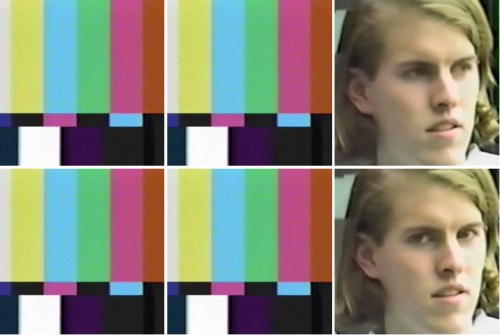
1991 is a new magazine dedicated to chronicling the notable cultural events of a certain year. 1991 happens to be the first installment, and future editions will follow the format for different years. In honor of the inaugural issue, QS is sharing one of its more pertinent stories with everyone, which happens to be about a video part filmed at a certain baseball diamond on Avenue A and E. 9th Street…in 1991. (It even ends with a fight! #onbrand.) Buy the 82-page issue at 1991magazine.com.
Cameron Martin is well known in the art world as a painter of photorealistic forests, mountains, and cliffs. Born in 1970 in Seattle, Martin boasts a CV as impressive as any working artist, with exhibitions around the world, features in major publications, and inclusion in museum collections across the country.
As an acquaintance of Martin, I knew that he was once a professional skateboarder and a member of the fabled Bones Brigade, a team that included Tony Hawk, Rodney Mullen, and Steve Caballero. While researching 1991, I found a video on YouTube called “Cameron Martin 1991 freestyle skateboarding NYC.” The 1:08 clip shows Martin skating in Tompkins Square Park and then farther downtown, under the Twin Towers. His skating is fast, technical, and flawless. The tricks flow together in successions of lines that look improvised but likely took hours to get right. Though it’s seemingly unconnected to a full length or sponsor, “Cameron Martin 1991” has the same feel as the most influential videos of 1991, including Blind’s Video Days and Alien Workshop’s Memory Screen.
“There’s quite a story behind that video,” Martin said when I asked him about it. We met at his studio in Greenpoint, and he was right—there is an interesting story behind the video. Here it is in his words. — N.
1991 ended up being the pinnacle and the end of my life in the skateboard industry.
In 1990 I was a sponsored amateur about to turn pro. I went to Europe and competed in a bunch of pro contests. When I was over there, I never expected this was going to happen at all, but Powell Peralta, who I was sponsored by, said they wanted to put out my pro model. It was a total shock because nobody gave a shit about freestyle at that time. I guess they figured that since Rodney [Mullen] wasn’t on the team anymore there was a gap to fill. I was just totally psyched. I couldn’t believe it.
I was going to NYU and skating pretty much every day, even in the winter when it was freezing. It was a little tricky because I was going to college full time and I was trying to be a pro skater. I went to contests and did demos when I could, and a lot of it took place in the summer.
At the Amateur National Championships in ’88 or ’89—I don’t remember—I had met the SHUT guys, and we got along really well. So when I moved to New York I just called them up and they kinda took me in and introduced me to everybody. For some reason I just clicked with them—Bruno [Musso] and Rodney [Smith] and a bunch of guys on their team. There weren’t that many skaters in New York at that time, so when someone showed up who was somewhat known, people were psyched.
My skating was heavily influenced by being in New York. When I lived on the West Coast, it was much more the traditional—not as many rolling tricks, trying to skate to the music, more like an ice-skating competition. Nobody respected freestyle. It wasn’t gnarly. It wasn’t aggressive. It was really tech. Things started to change around ’91 because street skaters were doing a lot of freestyle tricks, only down stairs or whatever. In New York my skating became almost like street skating. That’s the way anybody who was paying attention saw it was going, anyway.
Here’s the story of that video. Powell put out a video once a year or so and they were a big deal. When the new Powell video came out, it was screened in a theater and people went crazy. A lot of the companies didn’t have money for production for that kind of thing, but Powell was absolutely enormous at that time and the Bones Brigade videos were central to their whole enterprise.
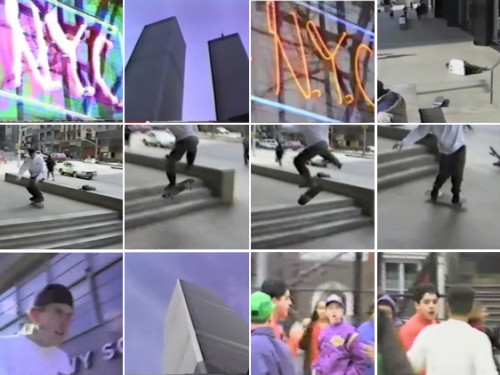
There was a big shift in 1990. Skateboarders were not being sold as personalities in the same way they were before. During the ’80s, on the Powell team it was all about creating these characters—Lance Mountain is the goofy guy, and Steve Caballero is the cool guy who plays in the band and wears suspenders, Mike McGill is kind of a Florida jock… Each person had their role in the Bones Brigade. But that was all going away, becoming uncool. Things were moving from rock star back to punk. In some ways it all became much more conformist. Everybody started to wear very similar, drab baggy clothing. A lot of people had super-short haircuts and a baseball hat.
Stacy Peralta had created this entire world through directing the Powell videos. He had spent years pouring himself into it. It was where he learned to make films, and you can see so much of its influence in the movies he’s making now. After he stopped skating in the ’70s, his life became constructing the Powell team, being the talent scout, the coach, the image-maker. It was amazing what he did. But everything was changing really rapidly and I am not sure if he could see it, or maybe it was just too difficult to accept.
So at one point when Stacy and I were talking about the upcoming video, he said, “Well, now that you’re in New York, I don’t know if we can send someone out there to film you.” I said, “Well, my roommate is a film student and I could just make my own part.”
That was already the way things were going. The H-Street video and the Blind video had come out—they were much more low-tech. Everybody was going to the handheld camcorders. That hadn’t really been happening that much up to that point. Stacy was shooting on 35-mm film sometimes, and the budgets were enormous for these things. But then things were starting to slip and the money wasn’t what it had been. He said, “OK, you can do your own thing.” He essentially told me they were going to put the part we made in the video—or that’s the way I heard it, anyway.
I shot that video with my roommate Mike Miller and we worked really hard on it. He was a student, so you can tell by the way it’s edited it’s not super- slick or anything, but it was pretty good, I think, for some guy who was a sophomore. I got a downstairs neighbor at my dorm to do the music. It was a big production for us, and I was super happy with it.
The last video that I had been in before that was the Propaganda video, and it was right on the cusp of when I was really switching over to doing more street skating. I was psyched to have my skating be perceived in a different way. I was switching. Not that I was going to become a street skater, but just that the style had changed. I also felt like I was skating better than I ever had before.
We filmed that YouTube video in the fall of ’91. We filmed it over the course of three days. I sent it in, and I didn’t hear anything.
Finally, I called Stacy. He was always really hard to get on the phone. When I finally talked to him he said, “Yeah, well, you know, I don’t think we can use the video. It’s too grainy and the edits are really rough. It just looks like it’s hand-done.” I was really bummed out, devastated. I said, “You got me all ex- cited about this and I got other people to work on it. This is the way things are going, man. You need to see this.” When I got off the phone I was super pissed.
After that, I wrote him this really long letter—so presumptuous on my part—just tearing him down, saying that he was out of touch with what was go- ing on. I cannot believe that I did it in retrospect. I was basically like, “Nobody wants to see skits and Native American masks and funky editing anymore. You’ve got to look at what’s going on with these other videos. This is the way they’re filmed, this is the future.”
Stacy didn’t want to hear any of what I was say- ing. He got in this huge fight with George Powell because he wanted to kick me off the team and George sided with me. They ended up splitting up pretty soon after that. I’m not saying it was be- cause of me, but it definitely was part of what was going on between them at the time, and it might have been the last straw. I felt really guilty about it, like I made this big mistake and then maybe I caused the breakup.
My part never got put out until someone put it on YouTube. That’s the only place it’s ever been seen.
I’ve never spoken to Stacy again since then. I know the whole thing really wounded his pride. It was awful. I beat myself up about it for years. I was so filled with regret. I wish I had been able to tell him the same thing but in a different way. He wrote me back, saying this is the most offensive thing and you have no idea how much money we’ve spent on you. It really ripped me apart. I had worshipped the guy for years. He was one of my heroes and I just got angry and disrespected him and ruined everything.
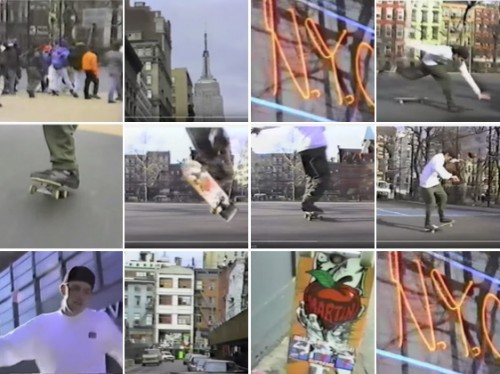
I kept riding for Powell for a while, but I became pretty disillusioned with the skateboard industry at that point. I went home to Seattle for the summer and I got this letter in the mail from Powell Peralta that essentially said, “The skateboard industry has decided that freestyle doesn’t exist anymore. If you want to try to become a street skater, we will go along for the ride with that, but we’re not going to make your model anymore.”
My body was already screwed up, and even though I loved the sport, I was just losing faith in the industry. I couldn’t really imagine my future…I love skateboarding, it was so much a part of who I was at that time, but there was no way I was going to try to become a street skater.
Everything in my life changed at that point. I dropped out of NYU. I moved back home to work for an artist in Seattle who was my high school painting teacher. I broke up with my girlfriend of two years. I kept skating, but I stopped wearing any company logos. I just didn’t want anything to do with the industry side of it anymore because I felt like I’d been this walking billboard for all these years. Once they turned away, I was like, “I’m not going to support that.”
I was skating better than I ever did when I filmed that video. And it was probably six or eight months after that that I walked away.



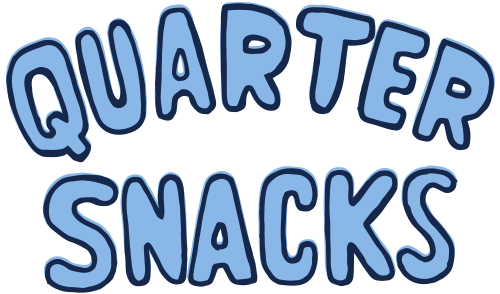
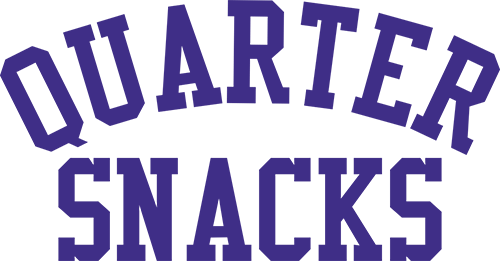

Will this be sold online only?
Yes, for now. Will start hitting a few shops later this month.
This is wild
first tfreport
inspiration behind the street fighter II intro? https://www.youtube.com/watch?v=lGSKZgEnbYI
I remember his part in Ban This and I definitely prefer the footage in NYC. Love the flatground lines and three step tricks..
its so nuts how this is what skating in ny looked like in 1991 and then how tech it started to look 1993, 1994 in philly, like fred rick reason doing real ledge tricks and shit
2 fucking year difference
This can only be bought in the USA right?
STACI P IS THE NAME OF ONE OF MA HOES AND I KEEPS HER BROKE
FOR THA RECORD PERALTA WAS/IS THE BEST JOKE THA INDUSTRY EVA HAD
VISION DAWG VISION
this is fucking rad. i feel proud wearing my LES quarternsacks shirt right now
-Jihad Shorty *vegas killer*
tf had no cracks
Rad, I always wondered what became of this dude. I was a freshman at Seattle U. and used to skate Seattle Center with this guy a bunch, he always killed it even though a lot of people thought freestyle was lame you could tell he knew his shit. Remember one time he came back from some NSA regional contest or something in late ’87-early ’88 raving about this new guy that Powell had gotten who was murdering it, turned out to be Ray Barbee. Anyway this is rad it’s good to see he’s doing well.
Back in the day u had to had guts, no joke. Tompkins sqare park downtown financial, the banks! Thats we used to skate all day. I rememer this one time we got kicked out of a spot and we striat up beat the shit outa a old lady, cuz we were mad, cant do that shit no mo righ?
Pretty sure beating up old ladies was never cool, even in the 90s…
Gino’s heelflip!
Sounds like Stacy was good at manipulating people into feeling guilty. He had a right to be mad, though I think the part is better watched on mute
Super sick style. Love that kickflip manual shovit combo!! Takes me back.
I’m fortunate to call Cameron a friend; he’s an even better person than skater, which is saying something. And he makes a mean stew!